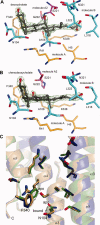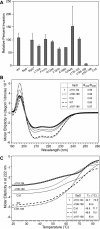The crystal structures of the Salmonella type III secretion system tip protein SipD in complex with deoxycholate and chenodeoxycholate
- PMID: 21031487
- PMCID: PMC3047063
- DOI: 10.1002/pro.537
The crystal structures of the Salmonella type III secretion system tip protein SipD in complex with deoxycholate and chenodeoxycholate
Abstract
The type III secretion system (T3SS) is a protein injection nanomachinery required for virulence by many human pathogenic bacteria including Salmonella and Shigella. An essential component of the T3SS is the tip protein and the Salmonella SipD and the Shigella IpaD tip proteins interact with bile salts, which serve as environmental sensors for these enteric pathogens. SipD and IpaD have long central coiled coils and their N-terminal regions form α-helical hairpins and a short helix α3 that pack against the coiled coil. Using AutoDock, others have predicted that the bile salt deoxycholate binds IpaD in a cleft formed by the α-helical hairpin and its long central coiled coil. NMR chemical shift mapping, however, indicated that the SipD residues most affected by bile salts are located in a disordered region near helix α3. Thus, how bile salts interact with SipD and IpaD is unclear. Here, we report the crystal structures of SipD in complex with the bile salts deoxycholate and chenodeoxycholate. Bile salts bind SipD in a region different from what was predicted for IpaD. In SipD, bile salts bind part of helix α3 and the C-terminus of the long central coiled coil, towards the C-terminus of the protein. We discuss the biological implication of the differences in how bile salts interact with SipD and IpaD.
Figures






Similar articles
-
NMR characterization of the interaction of the Salmonella type III secretion system protein SipD and bile salts.Biochemistry. 2010 May 18;49(19):4220-6. doi: 10.1021/bi100335u. Biochemistry. 2010. PMID: 20397637 Free PMC article.
-
Crystal structure of PrgI-SipD: insight into a secretion competent state of the type three secretion system needle tip and its interaction with host ligands.PLoS Pathog. 2011 Aug;7(8):e1002163. doi: 10.1371/journal.ppat.1002163. Epub 2011 Aug 4. PLoS Pathog. 2011. PMID: 21829362 Free PMC article.
-
NMR model of PrgI-SipD interaction and its implications in the needle-tip assembly of the Salmonella type III secretion system.J Mol Biol. 2014 Aug 12;426(16):2958-69. doi: 10.1016/j.jmb.2014.06.009. Epub 2014 Jun 18. J Mol Biol. 2014. PMID: 24951833 Free PMC article.
-
NMR identification of the binding surfaces involved in the Salmonella and Shigella Type III secretion tip-translocon protein-protein interactions.Proteins. 2016 Aug;84(8):1097-107. doi: 10.1002/prot.25055. Epub 2016 May 5. Proteins. 2016. PMID: 27093649 Free PMC article.
-
Förster resonance energy transfer (FRET) as a tool for dissecting the molecular mechanisms for maturation of the Shigella type III secretion needle tip complex.Int J Mol Sci. 2012 Nov 16;13(11):15137-61. doi: 10.3390/ijms131115137. Int J Mol Sci. 2012. PMID: 23203116 Free PMC article. Review.
Cited by
-
Protein export according to schedule: architecture, assembly, and regulation of type III secretion systems from plant- and animal-pathogenic bacteria.Microbiol Mol Biol Rev. 2012 Jun;76(2):262-310. doi: 10.1128/MMBR.05017-11. Microbiol Mol Biol Rev. 2012. PMID: 22688814 Free PMC article. Review.
-
Identification of Novel Type Three Secretion System (T3SS) Inhibitors by Computational Methods and Anti-Salmonella Evaluations.Front Pharmacol. 2021 Nov 16;12:764191. doi: 10.3389/fphar.2021.764191. eCollection 2021. Front Pharmacol. 2021. PMID: 34867388 Free PMC article.
-
Cryo-EM of the injectisome and type III secretion systems.Curr Opin Struct Biol. 2022 Aug;75:102403. doi: 10.1016/j.sbi.2022.102403. Epub 2022 Jun 17. Curr Opin Struct Biol. 2022. PMID: 35724552 Free PMC article. Review.
-
Key steps in type III secretion system (T3SS) towards translocon assembly with potential sensor at plant plasma membrane.Mol Plant Pathol. 2015 Sep;16(7):762-73. doi: 10.1111/mpp.12223. Epub 2015 Jan 29. Mol Plant Pathol. 2015. PMID: 25469869 Free PMC article. Review.
-
Biophysical characterization of the type III secretion tip proteins and the tip proteins attached to bacterium-like particles.J Pharm Sci. 2015 Feb;104(2):424-32. doi: 10.1002/jps.24047. Epub 2014 Jun 10. J Pharm Sci. 2015. PMID: 24916512 Free PMC article.
References
-
- Cornelis GR. The type III secretion injectisome. Nat Rev Microbiol. 2006;4:811–825. - PubMed
-
- Erskine PT, Knight MJ, Ruaux A, Mikolajek H, Sang NW, Withers J, Gill R, Wood SP, Wood M, Fox GC, Cooper JB. High resolution structure of BipD: an invasion protein associated with the type III secretion system of Burkholderia pseudomallei. J Mol Biol. 2006;363:125–136. - PubMed
Publication types
MeSH terms
Substances
Grants and funding
LinkOut - more resources
Full Text Sources

